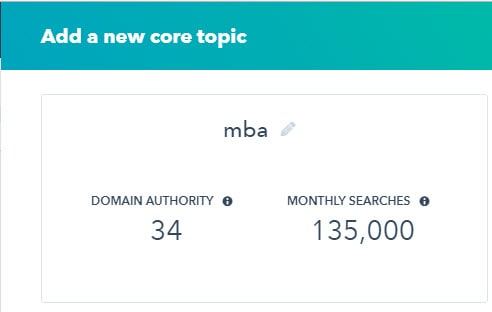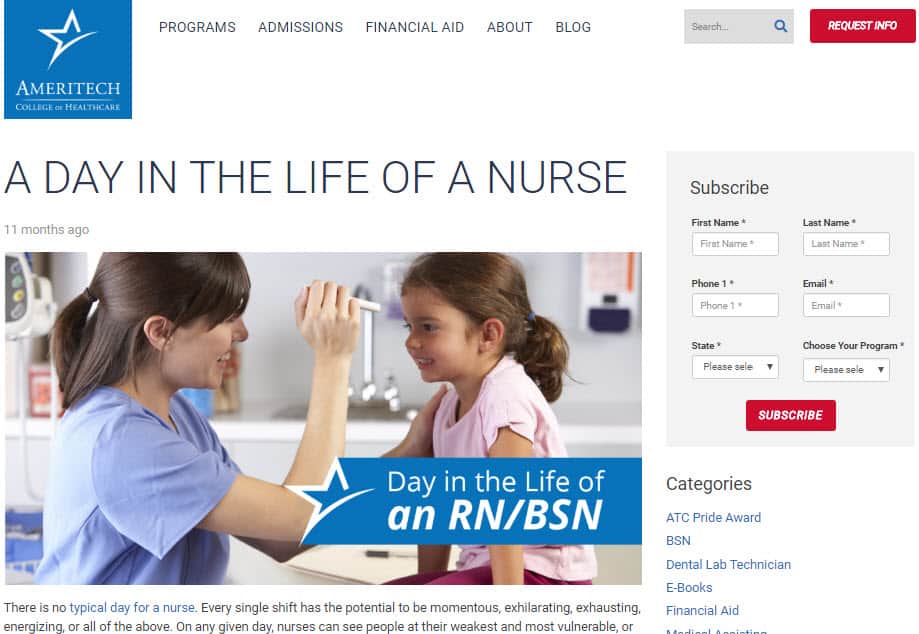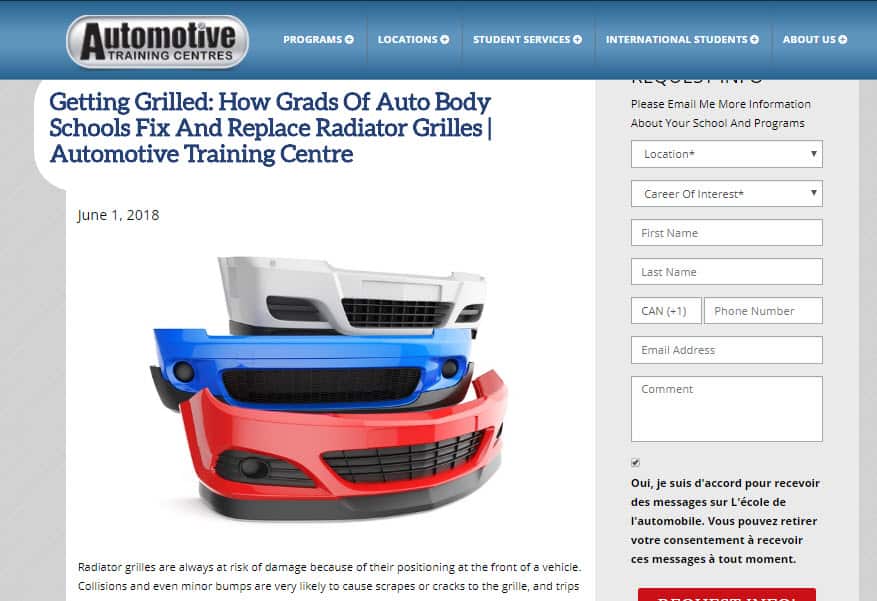
It was 1996 when Bill Gates penned his famous essay “Content is King.” In a remarkably prescient piece, the Microsoft founder detailed his vision of a future in which the internet enabled organizations of all kinds to easily create and share written, audio, and visual content, leading to an increased emphasis and importance on its creation.
Fast forward 22 years, and those who were paying attention to Gates’s words have reaped the benefits. Organizations in all sectors now strive to provide more valuable, engaging, and diverse forms of web content to communicate their message to the world. The content marketing revolution has been an especially natural fit for schools, many of whom have been able to draw on a range of valuable academic resources and expertise to cultivate reputations as trusted online voices.
Recently, however, the content creation boom has shown signs of reaching a saturation point. With 90% of business in all sectors now creating content for inbound marketing, it is becoming harder and harder to make yourself heard.
Faced with these challenges, many digital marketing experts have begun experimenting with innovative new strategic approaches in a bid to cut through the noise. Here are a few of the most intriguing.
1. Harmonize Your Education Content Marketing Strategy with Topic Clusters
In addition to the sheer volume of competing voices on the web, marketing professionals have also had to contend with a number of advances in search engine technology over the past few years, which have changed the way content is found and consumed.
Chief among these has been the introduction of sophisticated machine learning capabilities, such as those contained in Google’s Rankbrain and Hummingbird updates. These algorithms give search engine crawlers the ability to recognize the semantic relationship in searches, and make better judgements about user intent.
As search engines get smarter, however, SEO experts are changing the way they approach them. Because search engines can more easily recognize the relevance of content to many different variations of similar search queries, the focus has now shifted from targeting specific keywords to building authority on particular topics.
This is where the ‘Topic Cluster’ model comes in. Championed by HubSpot, topic clusters are a fresh approach to not just content strategy but web architecture. In this model, organizations choose a specific topic they want to rank for and create a series of posts designed to cover it in as much depth as possible.

A topic cluster can be broken down into 3 main components:
- Pillar Content- Each topic cluster is built around a pillar page. This is a long-form, comprehensive piece which provides a broad overview of each area of a particular topic. The pillar page Hubspot created on Instagram Marketing – which is over 8,000 words long – serves as a good example. Have a look at the table of contents below for an idea of the huge breadth of subjects the post covers:

- Cluster Content- Once your pillar content has been created, the aim should be to create a number of additional posts which go into even further detail about different subtopics related to your main theme. These cluster pages can be delivered in many different formats, and could include blogs, videos, infographics, checklists, and more.
- Hyperlinks- Your topic cluster is tied together with hyperlinks. Each of your cluster pages should be linked in your pillar page as naturally and unobtrusively as possible. You might also place further links to other posts at the end of the piece. Additionally, there should be a link back to your pillar page on each of your cluster pages, preferably using the same ‘anchor text’ each time. In the Hubspot example, all of the cluster posts link back to the pillar page using the keyword ‘Instagram marketing’ as an anchor:

These links are what make topic clusters so powerful. By anchoring your cluster pages back to your main pillar page, you reinforce its authority, while the outbound links on the pillar page serve as a further signal to search engines that it provides all the possible information a web user might be looking for on the topic in one place. As a result, search engines recognize that the posts are connected, and the authority of the entire cluster is strengthened in unison.
As of now, this approach has yet to gain much traction in education content marketing, but it could offer some potential for schools looking to bring more focus and sustained growth to their strategies. For example, your school could create topic clusters around each of your programs.
As an experiment, let’s apply it to an MBA degree. A business school offering this kind of program could create a pillar page outlining the many features and benefits of obtaining an MBA, such as internship opportunities, specific courses in areas like finance, management, and marketing, career outcomes of graduates, and networking opportunities. From there, they could create posts that cover each of these topics more thoroughly:

HubSpot offers a special content strategy tool which can help you create topic clusters, and tag and track the success of each post within them. It will also give you suggestions for core topics, and a read of the average monthly searches and your current domain authority for the topic you choose:

And the best part? You may already have a lot of the content you need. If you have been creating content regularly for a while, you will probably find that many of your posts can be repurposed to fit within a particular topic cluster. As you generate new ideas, you can create more posts and add them to it, or even create subclusters around your subtopics. The result could be a noticeable and lasting boost to your SEO, as well as an abundance of useful, engaging content that will cover all the most pressing questions and concerns of prospective students.
2. Keep Your Evergreen Content Thriving with Historical Optimization
Digital marketing professionals love to talk about ‘evergreen content.’ In simple terms, evergreen content is anything which is expected to have lasting value, and that you can expect to be continuously referred to by visitors to your website for many months or years. For schools, this could mean anything from a study guide, to a pre-arrival checklist for incoming students, to a blog or video about a particular course, subject, or idea.
The beauty of evergreen content is that its online authority – and therefore its search ranking – will grow over time, meaning it can continue to attract and engage new leads long after you have put the work into creating it. It’s quite common for posts like this to be among the most popular of your web pages, and for a small number of pages to attract the bulk of your web traffic.
Imagine, then, if you could find a way to gain even more traction from your evergreen content. That’s where historical optimization comes in. A simple but ingenious tactic, historical optimization involves taking your old posts, updating and refreshing their content, optimizing them based on their existing performance data, and republishing them for improved results.
This approach can be very useful if you have posts which attract high amounts of traffic but low conversion rates, or vice versa. Historically optimizing them is an opportunity to figure out where you went wrong with the help of your existing analytics data, and tweak elements of the post to rectify it. It can also be a great way to further drive home the impact of your most popular posts. Schools may also find it a good fit for seasonal content, such as blogs and guides for new students in the lead up to September, or study and exam tips towards the end of the year.
Example: This blog post was published by Dalhousie University in 2013.

Nearly five years later, it remains on page one of Google Search results for ‘university study tips.’ A high performing post like this could be perfect for historical optimization.

Once you have identified the post you want to optimize, there are 3 steps to the process:
- Refresh and update the post- It’s important that you make significant updates to the posts you apply this approach to in order to truly see its full benefits. Check your old posts for any information that may be inaccurate or out of date, such as statistics and research, information about your programs, or even references to current events. You can also consider whether anything useful could be added to the post that wasn’t considered or known when it was first created.
- Optimize Your Post- This is the fun part. Historical optimization is based around the idea that you optimize your old posts to reflect the searches they are actually being found for, rather than what you may have originally been targeting. You can use keyword tracking tools like Google Search Console or HubSpot’s Growthbot to find ideas. For instance, a language school in the UK may have been focusing on an academic keyword like ‘intensive ESL program’, but find their post is actually found more in a location based search like ‘study in the UK.’ Armed with this knowledge, you can then adapt the SEO elements of the post, tweaking your title tags, H1s and H2s, body text and links to better target your new keywords. If you’re dealing with a post that attracts high traffic but low conversions, you could also look at making the CTA more compelling in the hopes of better encouraging prospective students to take the next step.
- Republish the post as new- Once you are satisfied the post has been fully optimized, update it and change the publishing date to the present (for good faith, be sure to add a note at the end indicating that it was originally published earlier but has been updated). Search engines reward recency, but also existing page authority. By republishing the post as new, it will retain any SEO authority it has already gained, while also being identified as fresh and current. It’s the best of both worlds.
This strategy also ties in nicely with the topic cluster approach. If you are looking to include any of your old posts in a particular cluster, historical optimization can be a good way to ensure they are fully updated and optimized to maximize their results, and to anchor and link them properly to your pillar content.
Keep in mind, however, that this tactic is only likely to see results if your school has been publishing content consistently for a prolonged period of time. You should also allow for at least six months to pass before attempting to apply it to an existing post. Most importantly, historical optimization should be a way to supplement your other content development efforts, and never be used as a substitute for creating new content.
3. Seize ‘Micro Moments’ to Boost Mobile Student Recruitment
What makes you reach for your phone to surf the internet? You might spend large blocks of time researching for a project at work, or make a point to sit down and read articles on some of your favourite sites, but apart from that, you’ll likely think of small moments, events in your life that prompt you to seek out information.
Perhaps you arrive home and don’t feel like cooking, so you search for takeout, or you have a technical problem with some software and seek out advice on how to fix it, or you realize a conference you plan to attend is coming up and you need to book a hotel. Modern society relies heavily on mobile search to be close at hand, and provide the answers to any number of needs, wants, and wonderings.
Google has a name for these instances – “micro-moments” – and believes that they are when modern internet users are most open to being influenced by brands. By anticipating these moments and making quick, useful, content available, digital marketers can foster and grow their audience. For schools, thinking about content in terms of micro-moments could be the key to reaching today’s mobile literate prospective students in a more impactful way.
Google’s team breaks down micro-moments into four broad categories:
I-Want-to-Know Moments– These are moments when people are not firmly considering a product or service, but their curiosity has been triggered, and they want to find out more.
For example, imagine someone unfamiliar with your school meets one of your alumni, who proceeds to talk about how great your programs, campus, and instructors are. This might prompt them to reach for their phones to find out more.
Alternatively, say an individual encounters someone working in a profession they had never really thought about, but which seems like it might be a good fit for them. A school that can provide concise clear details about what it entails and the opportunities available might just find themselves attracting a new prospect.
Example: This blog from Ameritech College about a day in the life of a nurse could be the perfect answer to an I-Want-to-Know Moment.

I Want-to-Go Moments- These are moments where internet users specifically explore local options. For example, they might be searching for a restaurant near them, or trying to find tourist attractions in a particular city before a vacation.
In the context of content marketing for education, this might relate to when a prospect begins to research particular study destinations, such as an international student looking at the options available in a certain country, or a local resident looking for a career or community college near them.
I-Want-to-Go-Moments are all about optimizing your content for localized searches, ensuring that your institution can be easily found by an internet user with a specific destination in mind. Good practices for targeting these particular situations mighty include optimizing for local keywords, and featuring blogs, images, and videos that highlight and emphasize your location.
Example: This video from language school LAL London does an excellent job of highlighting the institution’s location, and its SEO-friendly title ‘Learn English in the UK’ makes it perfect for an I-Want-to-Go moment.

I-Want-to-Do Moments- These are moments where internet users are specifically looking to find out how to do something. They might be looking to fix a problem, accomplish a goal, or learn something new.
As trusted sources of knowledge, schools can be an excellent source of information on these occasions. An ESL school might publish a blog about grammar tips, for instance, or a trade school might make an instructional video about how to fix a basic household problem.
Capitalizing on I-Want-to-Do moments demonstrates the depth of your knowledge and expertise your school possesses, which can be crucial to building trust and confidence. It can also be a great way to grab the attention of a prospective student with a casual interest in the area of study you offer. By satisfying their initial curiosity, you can then nurture it into more solid interest.
Example: Automotive Training Centres do a great job of creating how-to blog posts outlining steps for fixing small auto problems. Given many of their prospective student base may already be fond of tinkering with cars in their spare time, this strategy can be great way to encourage them to turn their hobby into a career.
 I-Want-to-Buy Moments– These are moments when an individual has definitively decided that they want to invest in a particular product or service. In relation to student recruitment, this moment will usually occur after many months of careful research and consideration.
I-Want-to-Buy Moments– These are moments when an individual has definitively decided that they want to invest in a particular product or service. In relation to student recruitment, this moment will usually occur after many months of careful research and consideration.
Thinking in terms of I-Want-to-Buy moments can be crucial. When a prospective student reaches this stage, it doesn’t mean that the work is done. They may still be considering a few options, and need that extra push over the line to opt for your institution. Creating posts and pages related to application tips, information about visas, accommodation, and other elements that leads at this point in the enrollment journey consider could be just what you need to capitalize.
Example: A post from the University of Greenwich offering tips for prospective students looking to complete their UCAS application (the UK’s centralized application system for university entry). By offering this information on their website, the school is ensuring that any prospective student who decides to apply has everything they need to know at hand.

While each of the approaches outlined in this blog have their merits, it’s important not to throw away any existing tactics that are getting results for your school. Nonetheless, there is always room for experimentation. Topic clusters, historical optimization, and micro-moments are all very fluid concepts which can be adapted and interpreted to suit your needs and tie in with your existing higher education content marketing initiatives.
You can also use all three in tandem. Topic clusters and historical optimization can be overlapping approaches to long-form content creation, while micro-moments can be a useful thought process to adopt when developing short-form content.
Whatever approach you take, it’s also important to keep in mind the need to create a diverse range of different kinds of content. Video, blogs, infographics, whitepapers, web pages and many other types of format can all be utilized within a wider approach, ensuring your school has as many different ways to get its message across as possible. By maintaining a multifaceted approach, and keeping quality in mind above all else, your institution can rise above the competition and get real results.







